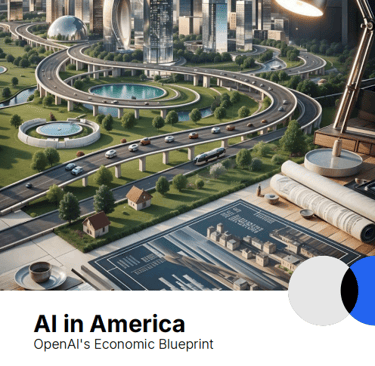Detailed Review of OpenAI’s Latest Report: AI’s Impact on America
Explore OpenAI's latest report on AI's transformative impact in America, policy insights, global implications, and strategies for equitable innovation


Artificial intelligence (AI) continues to reshape the global landscape, and OpenAI’s latest report, AI in America: OpenAI's Economic Blueprint, provides a comprehensive roadmap for maximizing AI’s potential while addressing its associated risks. This detailed review unpacks the key insights and proposals from OpenAI’s report, underscoring the transformative power of AI and the strategic steps needed to ensure its benefits are equitably distributed across the United States.
1. The Vision for AI in America
OpenAI’s mission is to develop AI that benefits everyone by solving hard problems in sectors like healthcare, education, and public policy. The report emphasizes AI’s ability to:
Accelerate medical breakthroughs.
Enhance educational outcomes through personalized lesson planning.
Improve efficiency in government services.
Foster creativity and accessibility for artists.
Strengthen national security by protecting military personnel.
With over 300 million global users, including 3 million developers, OpenAI aims to champion equitable AI access while mitigating risks. The report underscores the urgent need for America to lead in AI innovation, not only for economic growth but also to safeguard democratic values.
2. Economic and National Security Imperatives
OpenAI highlights AI’s role as a cornerstone of national competitiveness and security. Key points include:
Strategic Resources: Chips, data, energy, and talent are vital for AI leadership. The US must harness these resources to outpace adversaries like China.
Global Investments: An estimated $175 billion in global funds awaits deployment in AI infrastructure. The US must act swiftly to attract these investments.
Democratic AI: Rules and regulations should align with democratic values, promoting free and fair competition while protecting against misuse.
3. Building AI Infrastructure
The report draws parallels between AI’s potential and America’s historical industrial transformations, such as the automobile boom. To capitalize on AI’s promise, OpenAI advocates for:
Energy and Compute Infrastructure: Building abundant and affordable energy sources and computing capabilities to meet AI demands.
AI Economic Zones: Creating zones that expedite permits for AI infrastructure projects, such as renewable energy facilities and data centers.
Talent Development: Training the next generation of AI-skilled professionals, particularly in regions underserved by previous technological advancements.
4. Policy Recommendations
To ensure AI’s benefits are shared widely, OpenAI proposes several actionable steps:
National Standards: Establish clear, nationwide AI regulations to avoid fragmented state-by-state rules.
Export Policies: Develop guidelines to responsibly share AI models with allied nations while restricting access to adversaries.
Collaborative Safety Measures: Form public-private partnerships to test and deploy AI systems with robust safeguards.
Educational Initiatives: Launch nationwide AI literacy programs to prepare workers and students for the AI-driven future.
5. Rules of the Road: Ensuring Responsible AI Use
OpenAI’s report emphasizes the importance of "rules of the road" to guide AI development and usage. These include:
Transparency: Ensuring users know the origins of AI-generated content through provenance data.
Child Safety: Preventing AI misuse to create harmful content and fostering strong partnerships with law enforcement.
Personalization: Allowing users to tailor AI tools to their preferences while maintaining data privacy.
6. Democratizing AI Access
OpenAI stresses that AI’s transformative power should be accessible to all. The report proposes:
Government Data Digitization: Making public sector data more accessible to AI developers to unlock insights and enhance policymaking.
National AI Research Resources: Funding research infrastructure to democratize access to computational and data resources.
Energy Innovations: Investing in sustainable energy solutions like fusion and advanced nuclear power to support AI infrastructure.
7. Implications for Other Countries and Businesses
While the report primarily focuses on the United States, its insights and strategies have broader implications for other nations and businesses:
Global Collaboration: Countries can adopt similar frameworks to foster AI development while maintaining ethical standards. Collaborative efforts, such as AI compacts among allies, can ensure shared safety standards and equitable benefits.
Local Innovation Hubs: Nations can establish regional AI innovation zones tailored to their unique industries, such as agriculture, manufacturing, or renewable energy.
Business Opportunities: Companies worldwide can leverage OpenAI’s recommendations to integrate AI into their operations, improving efficiency and competitiveness. AI tools can help businesses analyze market trends, optimize supply chains, and enhance customer experiences.
Equitable Development: Developing nations can prioritize AI literacy and talent development programs to ensure they participate in and benefit from the global AI ecosystem.
OpenAI concludes by reiterating the need for collaborative efforts between government, industry, and society. By aligning infrastructure development, policy-making, and public awareness, America can secure its position as a global AI leader. The report’s forward-looking vision envisions a future where AI not only drives economic growth but also enriches lives and upholds democratic values.
Conclusion
OpenAI’s AI in America: Economic Blueprint serves as a vital guide for harnessing AI’s potential responsibly. By addressing infrastructure needs, fostering innovation, and ensuring equitable access, the US can lead the AI revolution while safeguarding its core values. Beyond America, the strategies outlined offer a blueprint for other nations and businesses to leverage AI’s transformative power, creating a globally interconnected ecosystem that benefits all.
Report Reference : https://cdn.openai.com/global-affairs/ai-in-america-oais-economic-blueprint-20250109.pdf